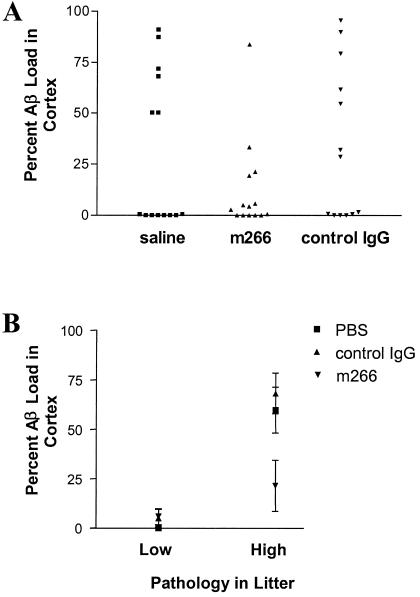Figure 4.
Chronic administration of m266 decreases Aβ burden in PDAPP mice. Four-month-old PDAPP+/+ mice were treated every 2 weeks for 5 months with saline (n = 14), m266 (n = 14, 500 μg), or control mouse mAb (n = 13, control IgG, 100 μg, PharMingen), all administered i.p. The % area covered by Aβ immunoreactivity as identified with a rabbit pan-Aβ antibody (BioSource International, Camarillo, CA) was quantified in the cerebral cortex immediately overlying the dorsal hippocampus as described (35). (A) At 9 months of age, about half of each group had still not developed Aβ deposits. In PBS- and IgG-treated animals, 6/14 and 5/13 mice, respectively, had greater than 50% of the cortex covered by Aβ staining. In contrast, only 1/14 m266-treated mice had this level of Aβ staining. The proportion of mice with this level of Aβ staining was lowered by treatment with m266 (P = 0.02, χ2 test). Levels of PBS-soluble and insoluble Aβ in cortex of PBS and m266 treated groups were as follows (mean Aβ in ng/mg protein ± SEM): soluble AβTotal, PBS, 0.115 ± 0.019, m266, 0.06 ± 0.007, P = 0.01; insoluble AβTotal, PBS, 4.64 ± 1.62, m266, 1.4 ± 0.34, P = 0.06; soluble Aβ42, PBS, 0.026 ± 0.002, m266, 0.020 ± 0.002, P = 0.04; insoluble Aβ42, PBS, 2.66 ± 1.18, m266, 0.62 ± 0.166, P = 0.09. (B) The variability in Aβ deposition within the groups was related in some way to parental origin. Even though all mice used were PDAPP+/+ transgenic mice, plaque burdens of 50% or greater were only seen in mice derived from four of eight breeding pairs (high pathology litters). Most mice from the other breeding pairs were free of plaques (low pathology litters). Using parental origin as a covariate, there was a strong effect of m266 in reducing Aβ burden. When comparing m266 to controls in all groups (high and low pathology litters), P = 0.0082. When comparing m266 to controls in only the high pathology litters, P = 0.00025.

